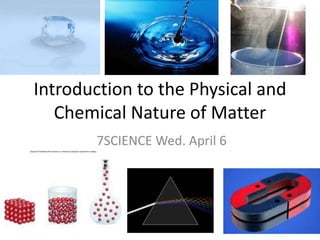
Introduction to the physical and chemical nature of
- 1. Introduction to the Physical and Chemical Nature of Matter 7SCIENCE Wed. April 6
- 3. What is matter? Matter Anything that takes up space and has mass Anything you can touch, taste or smell is matter NOT matter: thoughts, feelings,light, heat An atom is the smallest particle that makes up matter One or more atoms (atom + atom + atom..etc) is called a molecule Ex: one atom of oxygen and two atoms of hydrogen combine to form one water molecule
- 4. What makes something a solid, liquid or gas? There are many kinds of matter and these can be in different forms These forms are called states of matter: solid, liquid or gas The physical state of a type of matter depends on: how the atoms or molecules are arranged and how they move
- 5. Kinetic Theory of Matter The state of matter is determined by the arrangement and movement of atoms In 1827, a scientist named Robert Brown observed that particles he was studying in water were always moving Developed into an idea called the kinetic theory of matter: all particles in matter are in constant, random motion
- 6. Kinetic Theory of Matter Energy of these moving particles is called kinetic energy The higher the temperature, the faster the particles are moving and more likely they will collide into other particles If particles collide, the faster-moving particles (hotter) transfer some energy to the slower-moving particles (cooler)